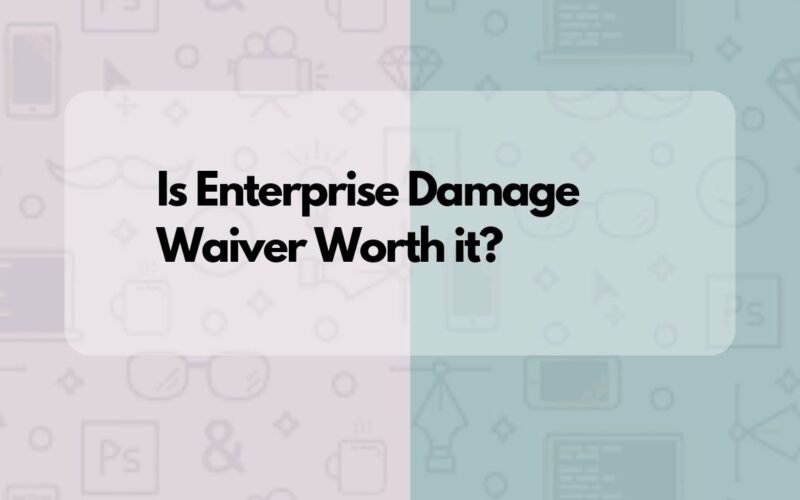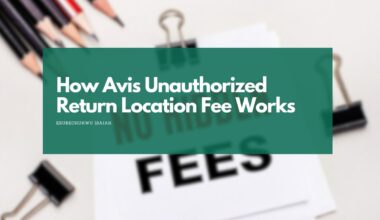As an Amazon Associate, I earn a small commission from qualifying purchases. Learn more about this.
As anyone who has rented a car knows, the decision to add a Damage Waiver can be a stressful one. With information flying at you from all directions, it’s hard to know what’s right for you.
In this article, we’ll simplify things by examining the pros and cons.
What does Enterprise Damage Waiver actually do?
So, you’re at the rental counter and you’re offered an Enterprise Damage Waiver (often abbreviated as EDW or simply referred to as a “Damage Waiver”).
It sounds important, almost like something you shouldn’t go without, but what does it really do for you?
Firstly, let’s clarify what a Damage Waiver is not.
It is not insurance. This is a common misconception. In essence, a Damage Waiver is an agreement between you and the car rental company.
By purchasing it, the company waives its right to charge you for certain types of damage to the vehicle while it’s in your possession. However, this waiver usually comes with quite a few limitations and exclusions, which are outlined in the rental agreement.
The Enterprise Damage Waiver typically covers damage to the rental car itself.
That means if you get into an accident, or the car gets damaged in some other way (like a fender bender or a scraped bumper), you won’t be financially responsible for the cost of repairs, or at least your liability will be significantly reduced.
The key term here is “significantly reduced”—not all Damage Waivers will cover the full cost, and you might still be responsible for a deductible.
Also, it’s worth noting what the Damage Waiver does not cover.
Most waivers won’t cover damage caused by reckless or negligent driving.
The same goes for damages caused when the renter violates the terms of the rental agreement, such as driving off-road or under the influence of alcohol or drugs. So, while you do get a certain level of protection, it’s not a free pass to treat the rental car however you wish.
One more thing to keep in mind is that the Damage Waiver may not cover “loss of use” charges—that is, the fees that the rental company charges for the time the car is out of service for repairs. This can add up quickly, so you’ll want to read the fine print carefully.
Is Enterprise Damage Waiver Worth it?
let’s cut straight to the chase
Is the Enterprise Damage Waiver worth it.
First off, let’s talk numbers.
The cost of adding an Enterprise Damage Waiver can vary widely based on a multitude of factors, such as the type of car you’re renting, where you’re renting it, and the duration of the rental.
The cost can range anywhere from $9 to $30 per day—or even higher in some cases. When you’re renting a car for multiple days, this can significantly add to your overall expense.
Now, is it worth it?
To determine this, consider your risk tolerance and the financial burden you could handle in the event of an accident.
Paying for damages out-of-pocket can be quite expensive; we’re talking hundreds or even thousands of dollars depending on the severity of the damage.
The Damage Waiver acts as a form of risk mitigation, essentially capping your liability and making it more predictable.
Another point to consider is your existing coverage.
Do you have a personal auto insurance policy that covers rental cars (not typically the case, but you could check)?
Many do, but not all policies are created equal. If your insurance offers comprehensive coverage for rental vehicles, the Damage Waiver may be redundant.
Additionally, some premium credit cards offer rental car coverage as a perk, so check your card benefits before making a decision.
But then, here’s our take on whether or not the damage waiver is worth it:
| Factor | Pros | Cons |
|---|---|---|
| Financial Liability | Caps potential costs in the event of vehicle damage | Additional daily charge can add up |
| Existing Coverage | Provides coverage if you don’t have a personal insurance policy | May be redundant if you have other insurance |
| Risk Tolerance | Offers peace of mind, especially if you’re risk-averse | May be unnecessary if you’re willing to assume risk |
| Terms and Conditions | Often straightforward and outlined in rental agreement | Comes with limitations and exclusions |
| Convenience | Simple to add to your rental agreement at the counter | Could be seen as a rushed, high-pressure decision |
| Psychological Comfort | Allows you to drive without worrying about potential costs | Could give a false sense of security |
Alternatives to the Enterprise Damage Waiver
1. Personal Auto Insurance
This is the first go-to for many renters. If you have a comprehensive auto insurance policy, it might already cover damages to rental vehicles.
But there’s a catch! Relying on this means you might need to pay a deductible, and any claim could increase your future premiums. Always verify coverage details with your insurer before declining the Damage Waiver.
2. Credit Card Benefits
Did you know some credit cards offer rental car coverage as a perk? It’s true.
Premium credit cards, especially travel-focused ones, can provide coverage for damages, theft, and sometimes even ‘loss of use’ charges.
The beauty of this is that it usually comes at no extra cost. However, this coverage is often secondary, meaning it kicks in after your personal auto insurance. Again, read the fine print.
3. Standalone Car Rental Insurance
Companies like Allianz and InsureMyRentalCar offer policies explicitly designed for rental cars.
They can provide comprehensive coverage, often at a fraction of the cost of the rental company’s Damage Waiver. This can be a great option for frequent travelers or those who don’t have personal auto insurance.
4. Bundle with Travel Insurance
If you’re renting a car for a trip, consider bundling your rental insurance with travel insurance. This approach can be cost-effective and provides a wide array of protections not just for your rental car, but also for other aspects of your trip.
Conclusion
So, is the Enterprise Damage Waiver worth it? The answer varies from person to person, depending on factors like existing coverage, risk tolerance, and personal preferences. Be sure to weigh these factors carefully to make the decision that’s right for you.







